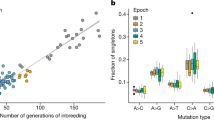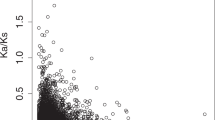Abstract
Polymorphisms exist at many genetic loci. At some loci, however, polymorphism is so high that tens and even hundreds of different alleles coexist in the population. Two such highly polymorphic systems are the immunoglobulin genes and the vertebrate major histocompatibility loci. The origin and maintenance of highly polymorphic loci remain open to debate but it seems likely that special mechanisms contribute to their variability and that their polymorphism serves important biological roles. The high degree of polymorphism at the H–2 class I major histocompatibility locus of the mouse has been documented by both tissue transplantation and serological methods1. More recently, molecular cloning and DNA sequencing of some of the class I genes has shown that most of the sequence variability is concentrated in the first two domains and is often found in clustered regions within them2–4. In addition, several groups have suggested that gene conversion events among the many class I genes may contribute to H–2 polymorphism5,6; such events would have to occur during meiosis to produce heritable alterations. The strongest evidence for gene conversion comes from sequence analysis of mutant class I H–2 alleles where concerted changes at adjoining sites in DNA imply gene conversion by distant but closely related loci5,6. We report here an analysis of these mutants indicating that the chromosomes containing loci that have experienced gene conversion originated from females. These data suggest a striking preference for mammalian meiotic gene conversion events during female rather than male gametogenesis.
This is a preview of subscription content, access via your institution
Access options
Subscribe to this journal
Receive 51 print issues and online access
$199.00 per year
only $3.90 per issue
Buy this article
- Purchase on Springer Link
- Instant access to full article PDF
Prices may be subject to local taxes which are calculated during checkout
Similar content being viewed by others
References
Klein, J. & Figueroa, F. Immun. Rev. 60, 23–58 (1981).
Moore, K. W., Sher, B. T., Sun, Y. H., Eakle, K. A. & Hood, L. Science 215, 679–682 (1981).
Evans, G. A., Margulies, D. H., Camerini-Otero, R. D., Ozato, K. & Seidman, J. G. Proc. natn. Acad. Sci. U.S.A. 79, 1994–1998 (1982).
Kvist, S., Roverts, L. & Dobberstein, B. EMBO J. 2, 245–254 (1983).
Weiss, E. et al. Nature 301, 671–674 (1983).
Schulze, D. H., Pease, L. R., Wallace, R. B. & Nathenson, S. G. Proc. natn. Acad. Sci. U.S.A. 80, 2007–2011 (1983).
Kohn, H. I. et al. Immunogenetics 7, 279–294 (1978).
Nairn, R., Yamaga, K. & Nathenson, S. G. A. Rev. Genet. 14, 241–277 (1980).
Bailey, D. W. & Kohn, H. I. Genet. Res. 6, 330–340 (1965).
Melvold, R. W. & Kohn, H. I. Mutat. Res. 27, 415–418 (1975).
Egorov, I. K. & Blandova, Z. K. Genet. Res. 19, 133–143 (1972).
Klein, J. in Biology of the Mouse Histocompatibility-2 Complex, 215–217 (Springer, New York, 1975).
Egel, R. Nature 290, 191–192 (1981).
Author information
Authors and Affiliations
Rights and permissions
About this article
Cite this article
Loh, D., Baltimore, D. Sexual preference of apparent gene conversion events in MHC genes of mice. Nature 309, 639–640 (1984). https://doi.org/10.1038/309639a0
Received:
Accepted:
Issue Date:
DOI: https://doi.org/10.1038/309639a0
This article is cited by
-
A de novo pathological point mutation at the 21–hydroxylase locus: implications for gene conversion in the human genome
Nature Genetics (1993)
-
Sexual preference of meiotic recombination within the H-2 complex
Immunogenetics (1987)
-
Man's place in Hominoidea as inferred from molecular clocks of DNA
Journal of Molecular Evolution (1987)
-
Sex and frequency of gene conversions in meiosis
Nature (1985)
-
Family organization of mouse H-2 class I genes
Immunogenetics (1985)
Comments
By submitting a comment you agree to abide by our Terms and Community Guidelines. If you find something abusive or that does not comply with our terms or guidelines please flag it as inappropriate.



